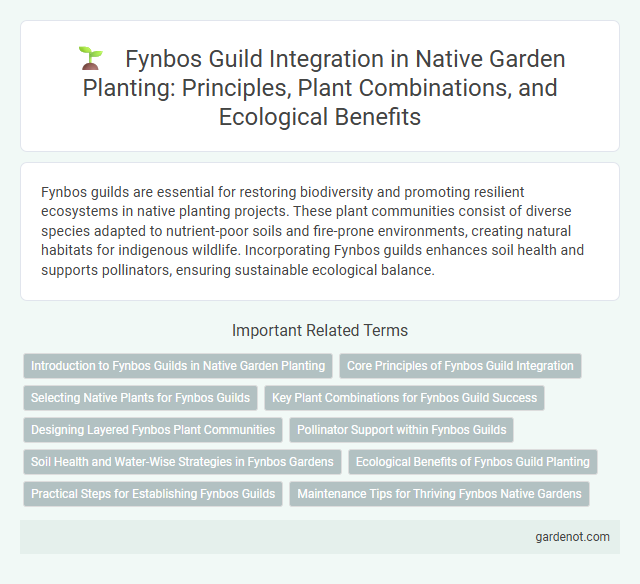Fynbos guilds are essential for restoring biodiversity and promoting resilient ecosystems in native planting projects. These plant communities consist of diverse species adapted to nutrient-poor soils and fire-prone environments, creating natural habitats for indigenous wildlife. Incorporating Fynbos guilds enhances soil health and supports pollinators, ensuring sustainable ecological balance.
Introduction to Fynbos Guilds in Native Garden Planting
Fynbos guilds represent specialized plant communities native to the Cape Floristic Region, characterized by their unique adaptations to nutrient-poor soils and Mediterranean climate. These guilds combine proteas, ericas, restios, and geophytes, creating a dynamic ecosystem that supports biodiversity and soil health. Incorporating Fynbos guilds in native garden planting enhances ecological resilience and promotes sustainable landscaping practices.
Core Principles of Fynbos Guild Integration
Fynbos guild integration centers on selecting plant species that naturally coexist and support each other's growth through mutualistic relationships, nutrient cycling, and complementary root structures. Emphasizing biodiversity, the guild incorporates nitrogen-fixing plants, deep-rooted species, and pollinator attractors to enhance ecosystem resilience and soil health. Properly integrating Fynbos guilds ensures sustainable restoration of native landscapes by mimicking natural community dynamics and promoting long-term ecological balance.
Selecting Native Plants for Fynbos Guilds
Selecting native plants for fynbos guilds ensures ecological harmony by incorporating species adapted to the nutrient-poor, acidic soils of the Cape Floristic Region. Key plants include proteas, ericas, and restios, which provide habitat complexity, support pollinators, and maintain fire resilience. Attention to plant relationships and growth habits enhances biodiversity and ecosystem durability in native garden designs.
Key Plant Combinations for Fynbos Guild Success
Key plant combinations for Fynbos guild success include proteas, ericas, and restios, which create a balanced microhabitat promoting mutual growth and biodiversity. Integrating nitrogen-fixing plants like certain legumes enhances soil fertility, supporting nutrient-demanding species within the guild. Strategic layering of these native species optimizes water retention and resilience against fire, essential for sustaining Fynbos ecosystems.
Designing Layered Fynbos Plant Communities
Designing layered Fynbos plant communities involves selecting native species that thrive in distinct vertical strata, promoting biodiversity and ecosystem resilience. Key species include proteas, ericas, and restios, which contribute to structural complexity and resource partitioning. Incorporating diverse Fynbos guild elements enhances habitat connectivity, soil stability, and supports indigenous fauna.
Pollinator Support within Fynbos Guilds
Fynbos guilds are crucial for sustaining diverse pollinator populations, as they provide a rich variety of flowering plants that bloom across seasons. Key species such as proteas, ericas, and restios attract specialized pollinators including birds, bees, and beetles, enhancing ecosystem resilience. Establishing native Fynbos guilds supports pollination networks essential for plant reproduction and biodiversity conservation.
Soil Health and Water-Wise Strategies in Fynbos Gardens
Fynbos guilds improve soil health by enhancing microbial activity and nutrient cycling through diverse native plants such as proteas, ericas, and restios. These plants exhibit deep root systems that stabilize soil structure and promote water retention, crucial for drought-prone Fynbos ecosystems. Integrating water-wise strategies, including mulching and strategic plant placement, maximizes water efficiency and sustains vibrant Fynbos garden growth.
Ecological Benefits of Fynbos Guild Planting
Fynbos guild planting enhances biodiversity by supporting a wide range of endemic plant species and pollinators unique to South Africa's Cape Floristic Region. These native plant communities improve soil health and water retention through deep root systems, reducing erosion and promoting ecosystem resilience. Furthermore, Fynbos guilds contribute to carbon sequestration, helping mitigate climate change while preserving essential habitats for local wildlife.
Practical Steps for Establishing Fynbos Guilds
Selecting native species that naturally coexist in the Fynbos biome enhances biodiversity and soil health, with proteas, ericas, and restios forming key guild components. Preparing well-drained, acidic soil and implementing mulching practices mitigate water stress and inhibit invasive species, promoting successful establishment. Strategic layering of plants by height and root depth optimizes resource use and fosters symbiotic relationships within the Fynbos guild ecosystem.
Maintenance Tips for Thriving Fynbos Native Gardens
Fynbos native gardens thrive with well-drained, acidic soils and full sun exposure, mimicking their natural Mediterranean climate. Regular mulching preserves soil moisture while reducing weed growth, essential for the delicate balance of Fynbos ecosystems. Pruning after flowering stimulates healthy growth and keeps the diverse plant guild vibrant and protected from disease.
Fynbos guild Infographic

 gardenot.com
gardenot.com